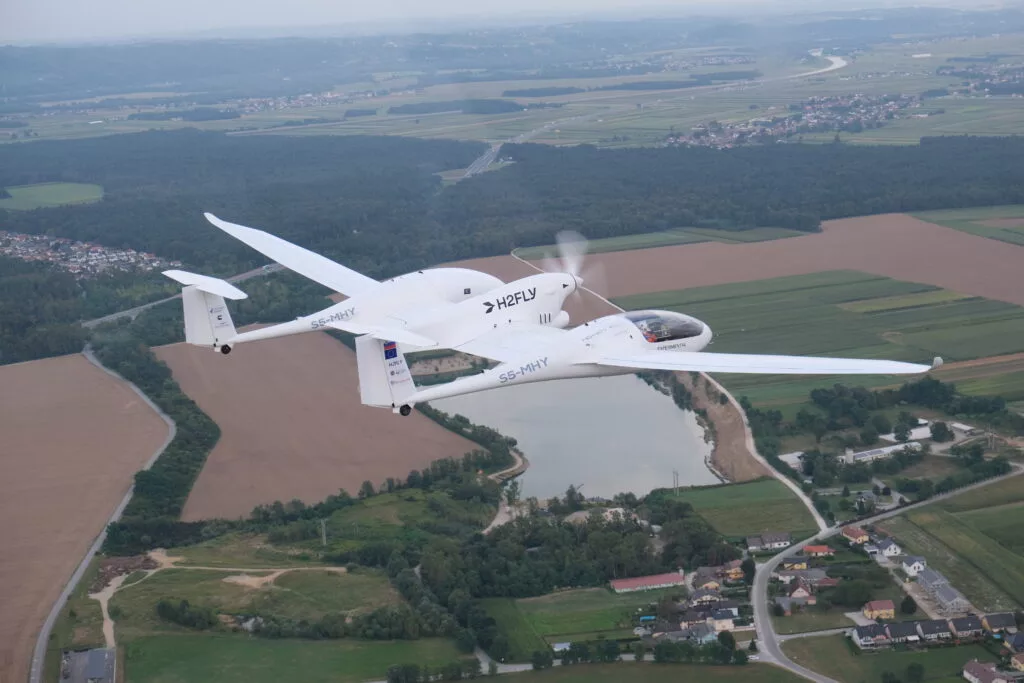Liquid hydrogen is a giant pain to handle, but it's one of the few technologies with a genuine chance of decarbonizing long-range flight. So it's huge news for clean aviation that H2Fly has now landed the word's first piloted liquid hydrogen flight.
Liquid green hydrogen is a clean fuel that emits nothing but water when burned, and can be run through a fuel cell to generate immediate power for electric motors. It carries around 2.8 times as much energy as jet fuel by weight – and in the world of aviation, where every ounce of weight makes a difference, that's huge.
On the other hand, it's a bit of a nightmare to work with. To keep it in liquid form, you need to keep it close to absolute zero temperature; it boils at just 20 Kelvin (-253 °C /-423.4 °F), given ambient pressure levels. And it might hold a high energy content by weight, but volumetrically its energy density is very low. You need a tank nearly four times larger than your regular jet fuel tank to carry the same amount of energy – so some of its weight advantage is lost in heavier equipment.
Still, once everything's taken into account, H2Fly says it's been able to double the maximum range of its twin-fuselage Pipistrel Taurus HY4 aircraft when switching from gaseous hydrogen fuel to liquid, taking it from 750 km (466 miles) to 1,500 km (932 miles). Both those figures dwarf what's possible with today's relatively heavy battery technology.

The odd layout of this aircraft allows the pilot to sit in the right-hand fuselage, while the fuel system is kept isolated in the left-hand fuselage. Meanwhile, the electric propulsion system and hydrogen-converting fuel cells are all housed in a central nacelle in between.
The company says it's now completed not just the world's first piloted liquid hydrogen flight, but three more missions, operating from an airfield in Maribor, Slovenia. The aircraft "saw safe and efficient operation throughout multiple flight tests," and analysis of the test flights validates H2Fly's expected range figures, according to a press release.
“This achievement marks a watershed moment in the use of hydrogen to power aircraft," said H2Fly co-founder Professor Josef Kallo. "Together with our partners, we have demonstrated the viability of liquid hydrogen to support medium and long-range emissions-free flight. We are now looking ahead to scaling up our technology for regional aircraft and other applications, beginning the critical mission of decarbonizing commercial aviation."
The company has certainly not been working on this flight alone, but has led a consortium including Pipistrek Vertical Solutions, Air Liquide, EKPO Fuel Cell Technologies, Fundacion Ayesa ad the German Aerospace Center. Funding has also been added by two German federal ministries and the University of Ulm.

With the technology now proven to a degree on a small, lightweight, low-altitude test aircraft, H2Fly is now moving to scale things up to a size relevant to commercial passenger and freight operations. It's working on a next-gen modular fuel cell power unit that can stack up to satisfy megawatt-scale power demands. The H2F-175 fuel cell is also designed to operate at altitudes as high as 27,000 feet (8,200 m), so it's targeted at regional airliners between 20 and 80 seats.
But it's going to take time to get such a thing developed, fully tested, integrated into airframes in a way that makes sense – and above all, certified for safe operation by EASA, the FAA and other aviation authorities. H2Fly puts no dates on when it expects to get these intermediate-range, zero-emissions powertrains into commercial service, but we'd expect it'll be well into the mid-2030s before this gear can start taking bites out of commercial jet fuel budgets.
Still, a historic moment and an enormous challenge overcome. We wish the companies involved speedy but safe progress.
Source: H2Fly







